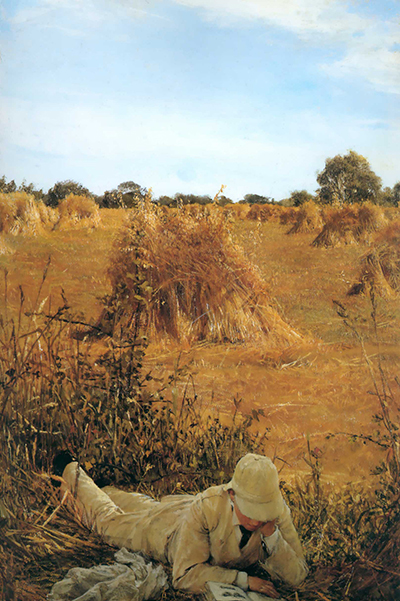Lawrence Alma-Tadema painted this picture in the Victorian era; where most of his artistic influence revolved around the royalty.
The inspiration, location and the artistic model was influenced by the English monarchy with which he sought refuge after the Franco-Prussian war of 1870. This is the cradle of his Victorian mode of painting, which had a significant influence on the Ninety Four Degrees in the Shade. The painting is a portrait of a boy or young man fully dressed, lying down on his belly reading a book. The contexture of the painting shows a deep contrast of the figure in the painting and the surrounding. Whereas he is in the field, he doesn’t look like a farm worker. The working assumption viewers of the portrait would have is that the young man sought the calmness of the farm to enjoy his reading. Behind him, there is harvested wheat stack up, ready for collection and processing.
The painting is done on canvas using oil and was completed in 1877. The painting is hand made to perfection, which is a characteristic of all Lawrence works. His Victorian style was unique, with emphasis on the texture, colour combination, contrast and the modernity. This style of painting earned him a fortune and a name in artistic circles. The Ninety Four Degrees in the Shade is housed at Fitzwilliam Museum, the University of Cambridge in the United Kingdom.
From his early days in the Royal Academy in Antwerp, he closely followed Gustaf Wappers and Louis Taeye where he learnt how to depict history in his paintings. He thereafter worked at August Hendrik Leys’ studio where he did his first painting The Education of the Children of Clovis – 1861. This painting did well in exhibitions and was bought and given to King Leopold of Belgium. His relocation to England was the precursor to the Victorian style of painting. It is here that he met, married and influenced his second wife Laura Epps on painting. His popular paintings during this era, besides the Ninety Four Degree in the Shade, include An Audience at Agrippa (1876), The Roses of Heliogabalus (1888), The Earthly Paradise (1891), Unconscious Rivals (1893) and Spring (1894).




